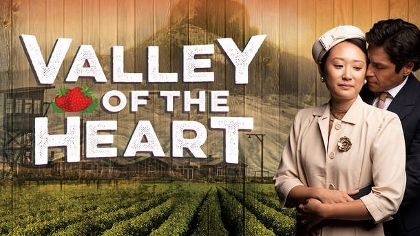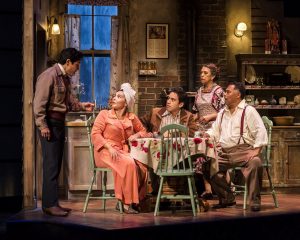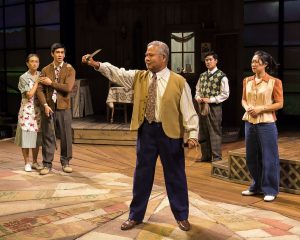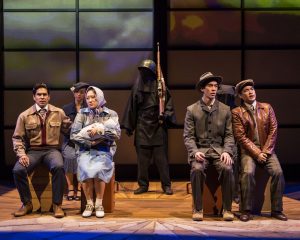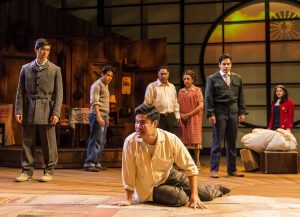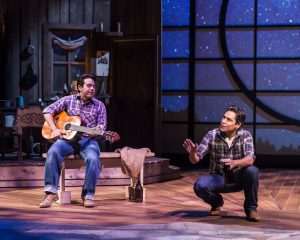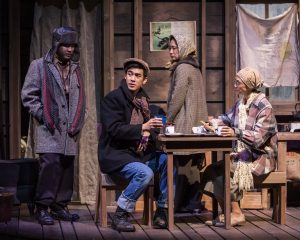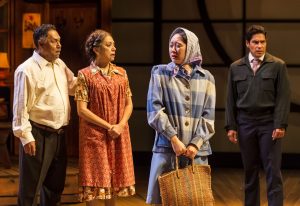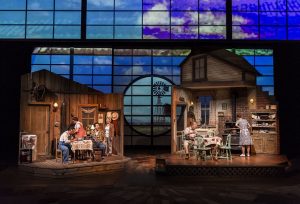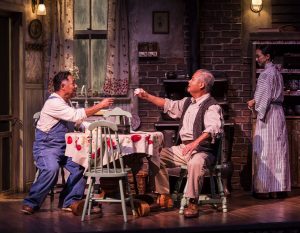VALLEY OF THE HEART ON ITS SLEEVE
Captivating stagecraft and a winning, although not always authentic, cast fuel this epic tale of war-time love. But the riveting aspects of a relationship between two American citizens — one Mexican, one Japanese — are diluted when didacticism dictates drama. Writer/director Luis Valdez has his heart in the right place, but he spends too much time putting it on his sleeve in his memory play, Valley of the Heart, now on at the Mark Taper Forum.
After the Japanese aerial attack on Pearl Harbor on December 7, 1941, the U.S. War Department mistrusted Japanese Americans as spies or saboteurs. With race prejudice and war hysteria in full swing (much of it thanks to the news), and a failure of political leadership to demand evidence, around 120,000 Japanese (those born both abroad and in the U.S.), were rounded up and placed in detention centers inland. Between 1942 and 1945, a total of ten internment camps opened, holding Japanese Americans — mostly from the Pacific Coast and half of them children — for varying periods of time in six states.
While the camps generally were run humanely – with families creating church, sports, entertainment and other activities — the prison-like conditions (barbed wire; military guards; poorly built accommodations; sparseness; a constant air of suspicion) made life punishing for many. Worse yet, Japanese were forced to sell their belongings, businesses and homes for a fraction of their worth at the onset, so many — some of whom were drafted — returned home or elsewhere after the war to completely rebuild from nothing.
As shameful as it is, it’s a fascinating time in history, and Valdez couldn’t have come up with a better story: In what is now Silicon Valley, a Japanese family lives on their successful ranch in a glorious Victorian house. Next door in a converted barn are their struggling sharecroppers, a Mexican American family. The oldest son (recounting this tale to us from 2001) and the Japanese daughter — who is slated for an arranged marriage — fall in love and get married after she becomes pregnant. Soon thereafter, the Japanese family is evacuated and the action goes back and forth between the farmland, where the son is now the foreman, and an internment camp in Wyoming.
For 160 minutes, the show vacillates between compelling, sometimes touching, storytelling and characters who spout statistics, facts and figures, right down to the type of food they’re eating for breakfast. Sometimes, the script smacks of agit-prop a la The Normal Heart, as if to incite us to anger; but the tactic backfires, because the information-drenched speeches, rife as they are with artificial dialogue, aren’t always character-defining.
Instead of fleshing-out characters, Valdez has characters flesh-out details: On a train to a center, one character states “The unfunny truth is that 120,000 patriotic Japanese Americans ripped from their lives, jobs and homes are being herded into ten Concentration Camps behind barbed wire. Manzanar and Tule Lake in California, Poston and Gila in Arizona, Amache in Colorado, Topaz in Utah, Minidoka in Idaho, Rhower and Jerome in Arkansas, and last but not least our glorious destination in Wyoming! God bless America ’¦ the ugly!” (“Behind barbed wire” and “Concentration Camp” are both mentioned five times in the show.) Some of the unfolding melodrama can engage, the rest is Encyclopedia Britannica. Because of this, the endless array of tragic events in Act II feels manipulative instead of organic.
The technical achievements are astounding and drop-dead gorgeous. John Iacovelli’s set consists of highly detailed, cutaway interiors of the farmhouse and barn, situated in front of a throng of monitors used to display David Murakami’s persuasive projections, conjuring up both the expansive outdoors and punishing cramped spaces, lit dramatically by Pablo Santiago. In Kabuki Theatre fashion, sliding shÅji screens and kuroko (black-clad stagehands) help to change the scene; the kuoko morphing into a jeep is a coup de théâtre. Lupe Valdez’s pitch-perfect costumes evoke the period while PJ Hirabayashi and Roy Hirabayashi’s original compositions and arrangements heighten the mood, aided by Philip G. Allen’s sensurround sound.
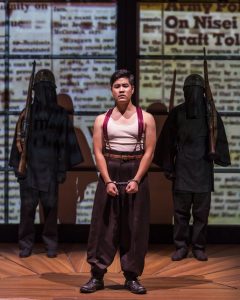 photos by Craig Schwartz
photos by Craig Schwartz
(click on picture for larger image)
Valley of the Heart
Center Theatre Group
Mark Taper Forum
Music Center, 135 N. Grand Ave
ends on December 9, 2018
for tickets, call 213.628.2772 or visit CTG
